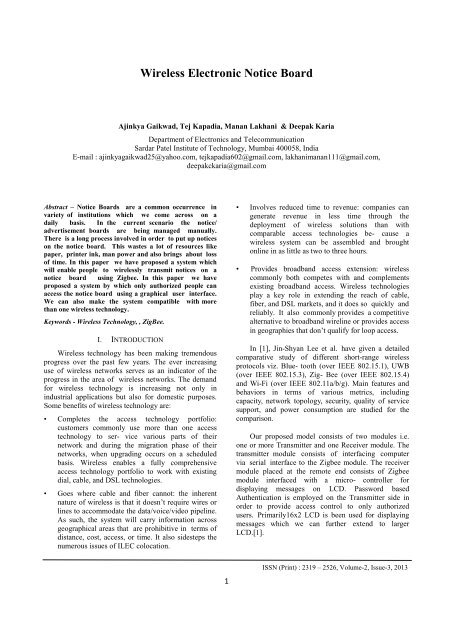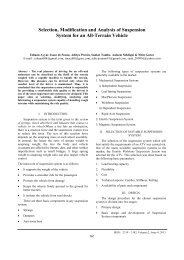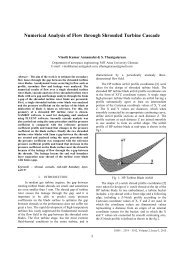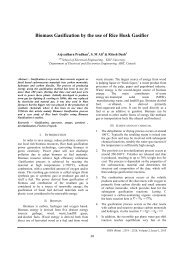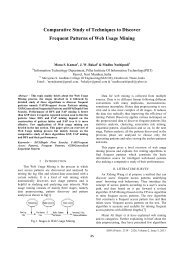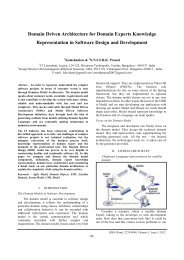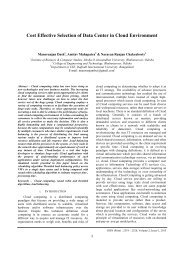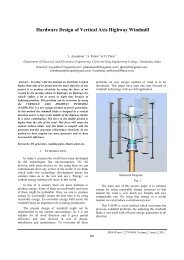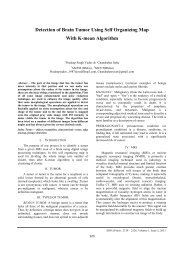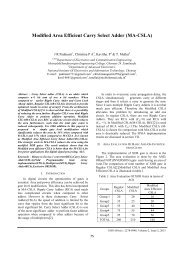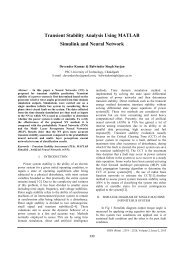Wireless Electronic Notice Board - IRD India
Wireless Electronic Notice Board - IRD India
Wireless Electronic Notice Board - IRD India
Create successful ePaper yourself
Turn your PDF publications into a flip-book with our unique Google optimized e-Paper software.
<strong>Wireless</strong> <strong>Electronic</strong> <strong>Notice</strong> <strong>Board</strong>Ajinkya Gaikwad, Tej Kapadia, Manan Lakhani & Deepak KariaDepartment of <strong>Electronic</strong>s and TelecommunicationSardar Patel Institute of Technology, Mumbai 400058, <strong>India</strong>E-mail : ajinkyagaikwad25@yahoo.com, tejkapadia602@gmail.com, lakhanimanan111@gmail.com,deepakckaria@gmail.comAbstract – <strong>Notice</strong> <strong>Board</strong>s are a common occurrence invariety of institutions which we come across on adaily basis. In the current scenario the notice/advertisement boards are being managed manually.There is a long process involved in order to put up noticeson the notice board. This wastes a lot of resources likepaper, printer ink, man power and also brings about lossof time. In this paper we have proposed a system whichwill enable people to wirelessly transmit notices on anotice board using Zigbee. In this paper we haveproposed a system by which only authorized people canaccess the notice board using a graphical user interface.We can also make the system compatible with morethan one wireless technology.Keywords - <strong>Wireless</strong> Technology, , ZigBee.I. INTRODUCTION<strong>Wireless</strong> technology has been making tremendousprogress over the past few years. The ever increasinguse of wireless networks serves as an indicator of theprogress in the area of wireless networks. The demandfor wireless technology is increasing not only inindustrial applications but also for domestic purposes.Some benefits of wireless technology are:• Completes the access technology portfolio:customers commonly use more than one accesstechnology to ser- vice various parts of theirnetwork and during the migration phase of theirnetworks, when upgrading occurs on a scheduledbasis. <strong>Wireless</strong> enables a fully comprehensiveaccess technology portfolio to work with existingdial, cable, and DSL technologies.• Goes where cable and fiber cannot: the inherentnature of wireless is that it doesn’t require wires orlines to accommodate the data/voice/video pipeline.As such, the system will carry information acrossgeographical areas that are prohibitive in terms ofdistance, cost, access, or time. It also sidesteps thenumerous issues of ILEC colocation.• Involves reduced time to revenue: companies cangenerate revenue in less time through thedeployment of wireless solutions than withcomparable access technologies be- cause awireless system can be assembled and broughtonline in as little as two to three hours.• Provides broadband access extension: wirelesscommonly both competes with and complementsexisting broadband access. <strong>Wireless</strong> technologiesplay a key role in extending the reach of cable,fiber, and DSL markets, and it does so quickly andreliably. It also commonly provides a competitivealternative to broadband wireline or provides accessin geographies that don’t qualify for loop access.In [1], Jin-Shyan Lee et al. have given a detailedcomparative study of different short-range wirelessprotocols viz. Blue- tooth (over IEEE 802.15.1), UWB(over IEEE 802.15.3), Zig- Bee (over IEEE 802.15.4)and Wi-Fi (over IEEE 802.11a/b/g). Main features andbehaviors in terms of various metrics, includingcapacity, network topology, security, quality of servicesupport, and power consumption are studied for thecomparison.Our proposed model consists of two modules i.e.one or more Transmitter and one Receiver module. Thetransmitter module consists of interfacing computervia serial interface to the Zigbee module. The receivermodule placed at the remote end consists of Zigbeemodule interfaced with a micro- controller fordisplaying messages on LCD. Password basedAuthentication is employed on the Transmitter side inorder to provide access control to only authorizedusers. Primarily16x2 LCD is been used for displayingmessages which we can further extend to largerLCD.[1].1ISSN (Print) : 2319 – 2526, Volume-2, Issue-3, 2013
International Journal on Advanced Computer Theory and Engineering (IJACTE)be asleep a significant amount of the time therebygiving long battery life. A ZED requires the leastamount of memory, and therefore can be lessexpensive to manufacture than a ZR or ZC. [6]A. Transmitter sectionFig. 3.Block diagram of TransmitterFig. 1.Zigbee devicesIV. SYSTEM DESIGNThe proposed system consists of Transmittersection and Receiver section. The complete schematic isas shown:Transmitter Section mainly consists of serial portinterfaced to Zigbee Module via MAX232. Module ofXBEE Series2 of Digi Inc. [4] has been used. The Xbeeradios are programmed using X-CTU software in APImode with the desired baud rate. Screenshots of X-CTUare shown in Fig. 6. A .Net based GUI application isdeveloped on PC which enables the user to displaymessage. The application authenticates user and thenallows to display message.Fig. 4.X-CTUFig. 2. SchematicFig. 5.Voltage Regulator3ISSN (Print) : 2319 – 2526, Volume-2, Issue-3, 2013
International Journal on Advanced Computer Theory and Engineering (IJACTE)A voltage regulator is designed to automaticallymaintain a constant voltage level. It is used tostabilize the DC voltages used by the processor andother elements. It is used in the Transmitter section tostabilize the voltage at the output of MAX232 beforepassing it to Zigbee Module.B. Receiver sectionFig. 6.Receiver sectionZigbee module on the receiver side isinterfaced with UART(Universal AsynchronousReceiver/ Transmitter) of Micro-ControllerPIC16F877A. Micro-Controller receives the messagefrom Zigbee module on receiver side and displays it onthe LCD screen. It also provides Synchronizationbetween Transmitter and Receiver.V. FUTURE SCOPE<strong>Electronic</strong> <strong>Notice</strong> <strong>Board</strong> is one of the applicationwhere Zigbee can be used effectively. It can also beused in Malls and Highways for Advertisement purpose.A moving display with variable speed can also be usedin place of static display.VI. CONCLUSION<strong>Wireless</strong> operations permit services, such as longrangecommunications, that are impossible orimpractical to implement with the use of wires. Itprovides fast transfer of information and are cheaper toinstall and maintain. This paper provides an efficientway of displaying messages on <strong>Notice</strong> <strong>Board</strong> using<strong>Wireless</strong> Technology. It also provides userauthentication in order to avoid any misuse of proposedsystem.VII. ACKNOW LEDGMENTWe would like to thank our mentor and guideDr. D. C. Karia for guidance and help throughout ourproject. We are also thankful to our Institute SardarPatel Institute of Technology, Mumbai, <strong>India</strong> forproviding all the facilities needed for our project.VIII. REFERENCES[1] J. S. Lee, Y. W. Su, and C. C. Shen, ”AComparative Study of <strong>Wireless</strong> Protocols:Bluetooth, UWB, ZigBee, and Wi-Fi”,Proceedings of the 33rd Annual Conference ofthe IEEE Industrial <strong>Electronic</strong>s Society (IECON),pp. 46-51, November 2007.[2] E. Ferro and F. Potorti, ”Bluetooth and Wi-Fiwireless protocols: a survey and a comparison”,<strong>Wireless</strong> Communications, IEEE, vol. 12, no. 1,pp.12-26, February 2005.[3] J. S. Lee, ”Performance Evaluation of IEEE802.15.4 for Low-Rate <strong>Wireless</strong> Personal AreaNetworks”, IEEE Transactions on Consumer<strong>Electronic</strong>s, vol. 52, no. 3, pp. 742-749 , August2006.[4] ”XBee Series 2 OEM RF Modules ProductManual”, Digi International, Inc., June 2007.[5] J. S. Lee and Y. C. Huang, ”ITRI ZBnode: AZigBee/IEEE 802.15.4 Plat- form for <strong>Wireless</strong>Sensor Networks”, Proceedings of IEEEInternational Conference on Systems, Man, andCybernetics, Taipei, Taiwan, vol. 2, pp. 1462-1467, October 2006[6] Safaric, S.; Malaric, K;Zigbee <strong>Wireless</strong> Standard, IEEE International conference on MultimediaProcessing and Communications, March 2006.4ISSN (Print) : 2319 – 2526, Volume-2, Issue-3, 2013


